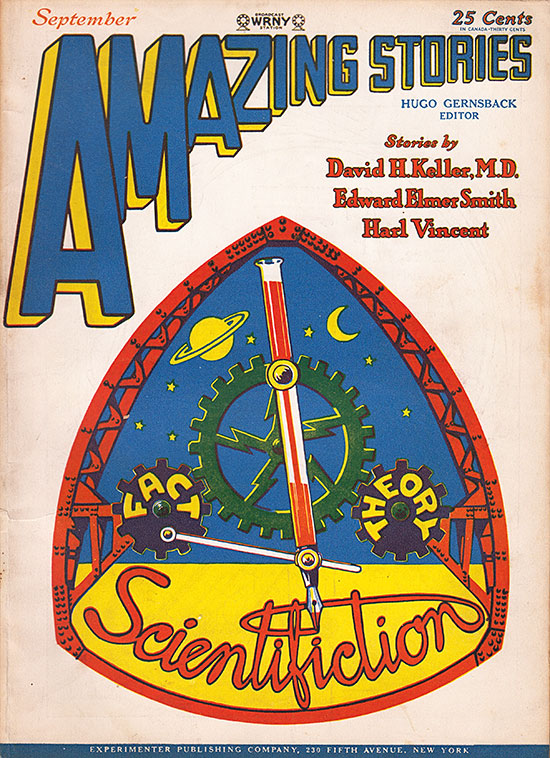But that’s the portmanteau that Hugo Gernsback created back in 1926 before science fiction was known as science fiction.
(Scientifiction was somewhat popular until the phrase “science fiction” caught on in the late 1940s and really took over.)
Though it’s not your typical pulp cover, I like to think of the September 1928 number of Amazing Stories as Great Pulp Art.
It doesn’t depict some exciting action from one of the stories inside the pulp, but this cover introducing the scientifiction logo represents science fiction as a genre unto itself.

A variation of the logo, from Forrest J. Ackerman‘s collection, sold on eBay last summer for $202.50. It was said to have been painted by Frank R. Paul, though no signature appeared on the painting. (No signature appears on the pulp cover, nor is an artist credit given inside the magazine.)
In the April 1928 number, Gernsback offered a $300 prize contest for a symbol for scientifiction. They received 965 entries. The winners, announced in the September number, were:
- First place ($100): A.A. Kaufman, 521 East 51st St., Brooklyn
- Second prize ($75): Clarence Beck, 108 Seventh Ave., West Bend, Wisc.
- Third place ($50): A.J. Jacobson, 400 N 58th Ave. W, Duluth, Minn.
- Fourth place ($25): Carl G. Wilkenhoener, 1429 Ardmore Ave., Chicago
- Fifth place ($15): Albert Schiller, 1553 46th St., Brooklyn
- Sixth place ($15): James S. Klar, 44 Dartmouth St., Springfield, Mass.
- Seventh place ($5): Jack Morganstein, 1394 Clay Ave., Bronx
- Eighth place ($5): B. Wheelock, N Warren, Pa.
- Ninth place ($5): E.J. Byrne, 5 West 75th St., New York City
- 10th place ($5): Rex Tullson, Grand Haven, Mich.
- Honorable mentions: Purcell G. Schube, 3444 Listton Ave., Cincinnati, Ohio; J.S. Taylor, 142 Richmond St., Charlottetown, P.E.I., Canada; Eric Aldwinckle, 56 Scarboro Rd., Toronto, Ontario, Canada; Philip Santry, 23 Minerva St., Swampscott, Mass.
Of Kaufman’s design, Amazing Stories said:
It was a crude design at best, but it was the idea and not the artistic effort that counted.
Science is represented by the gear wheel, while the pen represents the fiction part. Here, then, we have Fact and Theory. After we had been satisfied that Mr. Kaufman’s idea was the best one, we started to amplify his original idea. In doing so, we borrowed the shape of the design of the second prize winner, Mr. Clarence Beck; and from the third prize winner, Mr. A.J. Jacobson, we borrowed two extra wheels, these to mesh with Mr. Kaufman’s single wheel.
In substance, Mr. Kaufman’s prize-winning design is preserved in the strictest sense, except for a few additions. It was our aim to incorporate as much science as possible in the design, so the frame of the design, representing structural steel, suggests more machinery. The flashes in the central wheel represent Electricity. The top of the fountain pen is a test tube, which stands for Chemistry; while the background with the moon and stars and planet, give us the science of Astronomy.
We believe you will agree with us, that this makes an ideal trade-mark for Scientifiction, and we also admit that we are happy to have had solved for us a difficult problem.
The logo graced the covers of Amazing Stories from November 1928 through March 1929. The next issue, dated April 1929 and missing the emblem, would be Gernsback’s last; he lost ownership of the magazine due to debt.

